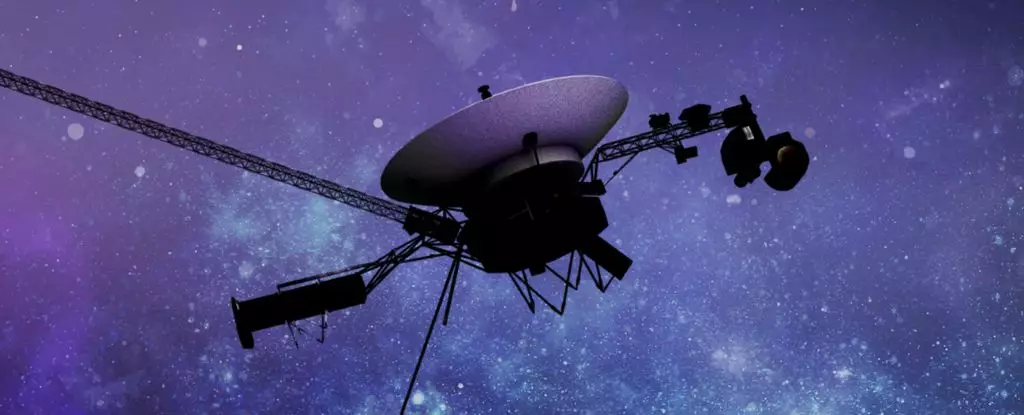NASA’s Voyager 1 spacecraft, an iconic symbol of human innovation, recently captured the attention of astronomers and space enthusiasts alike when it temporarily lost communication with Earth. This incident, which unfolded in October 2023, served as a stark reminder of the challenges inherent in exploring the vast and inhospitable environment of interstellar space, even as humanity’s technological prowess pushes the boundaries of what is possible.
Voyager 1, launched in 1977, currently resides nearly 25 billion kilometers (approximately 15.3 billion miles) away from Earth, making it the most distant human-made object in the universe. At such a staggering distance, signals take nearly 23 hours to travel one way, significantly complicating the conditions under which NASA communicates and operates the probe.
The trouble began on October 16 when a seemingly simple command was sent to activate one of Voyager 1’s heaters. Instead of complying with the request, the spacecraft went silent, leaving mission scientists in a quandary. The delay in solidifying communication was not immediately apparent, as it took two full days for NASA to recognize the absence of a response from Voyager 1. This delay underscores not only the vastness of space but the inherent complexities of communicating across such distances.
After missing its scheduled return call on October 18, NASA’s Deep Space Network (DSN) initiated a search for the probe’s signal. Eventually, they were able to locate it, albeit on an alternative frequency, indicating that Voyager 1 had engaged its built-in fault protection system. This protective measure activates when the craft draws too much power, risking the usual functions and prioritizing energy conservation instead.
The Role of Fault Protection Systems
Upon examination, NASA engineers determined that when instructed to power its heater, Voyager 1 inadvertently disabled its X-band transmitter, the primary means of contact with Earth, due to this fault protection response. The voltage fluctuations triggered an automatic adjustment that reduced power consumption by switching communication channels. Unfortunately, the alternative S-band transmitter that kicked in is not only less powerful but also significantly dimmer, raising concerns about whether it could effectively relay signals back to Earth.
Following the disconnection, engineers worked tirelessly to restore communication channels. A message sent on October 22 confirmed that the S-band transmitter was operational, much to the relief of the team. Nevertheless, there remains a cautious approach to re-engaging the X-band system until the underlying issue is thoroughly diagnosed, a process that continues as of now.
What stands out in this situation is not merely the technical challenge itself, but the fact that these diagnostic measures are being conducted on technology that is nearly half a century old. Over the years, Voyager 1 has experienced a series of malfunctions, including a memory glitch in 2022 that resulted in distorted data over several months, and more recently, a memory chip corruption that prevented the transmission of useful information.
The aging of the Voyager spacecraft heightens the urgency for maintaining their functionality. As they venture further into interstellar space—an uncharted territory for human-made vehicles—the importance of each piece of equipment becomes increasingly critical. Both Voyager probes are expected to continue their scientific endeavors until approximately 2025, when diminishing power reserves will likely render them incapable of further data collection.
The Future of Voyager and Human Legacy
Looking ahead, the timeline for Voyager 1 and its twin spacecraft, Voyager 2, reveals a sobering fate. By 2036, they are projected to drift beyond the reach of NASA’s Deep Space Network, making it difficult to track their signals. The eventual passage through the Oort Cloud, followed by a close encounter with neighboring stars in about 40,000 years, solidifies their status as lasting relics of human exploration.
As these probes continue their interminable journey into the cosmos, they carry with them the remnants of human culture—the Golden Records filled with music, images, and messages meant to represent our species. In their silence, they represent a profound metaphor for human aspirations to reach beyond Earth, even as they too will ultimately succumb to the vast, cold darkness of space.
The story of Voyager 1 not only highlights the intricacies and challenges of interstellar communication but serves as a testament to the enduring spirit of human exploration. Even when faced with adversity, our efforts to understand the cosmos remain unfaltering, as do the lessons learned from the trials of our most daring missions.


Leave a Reply